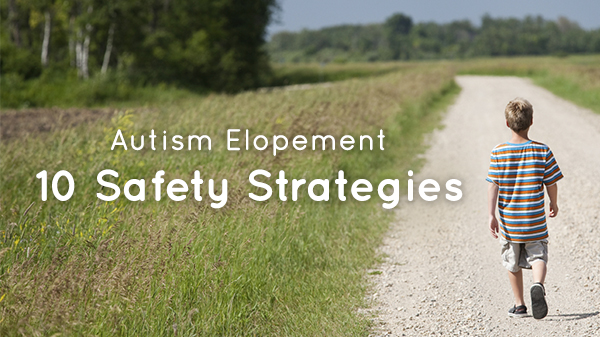
Autism elopement or wandering is a common challenge. Sometimes children with autism roam to a favorite spot or need distance from sensory stimulation. Try to give your child a way to signal sensory overload, such as a specific gesture or word. This can alert you to the need for a break. Read on for 10 helpful strategies for autism elopement or wandering.
STRATEGIES TO MANAGE AUTISM ELOPEMENT OR WANDERING
- It takes a village. No parent should go it alone. Inform friends and neighbors of your child’s tendency to wander. Give them ways to contact you if they see your child wandering. Guide them on how best to interact with your child.
- Use community resources. Many local police departments train their officers to support families with children who have special needs. Contact your local precinct. If possible, arrange to introduce your child to the local police officers to establish contact and familiarity.
- Home security. Locks on doors and windows should be out of reach from your child. Alarms or chimes can alert you if the door is opened without your presence. Fences with locking gates can secure your backyard or limit access to areas with water like a swimming pool.
- ID Bracelets. An ID bracelet or necklace is especially helpful for non-verbal children and can help get them get home quickly when found.
- Use visual cues. On the doors in your home, position signs at your child’s eye level. Use words and/or pictures to remind your child not to leave without you.
MORE HELPFUL IDEAS, FROM SOCIAL STORIES TO SWIMMING LESSONS
- Read Social Stories. Help your child understand your expectations by reading social stories together. For ideas and social story examples, click here.
- Swimming lessons. Some children with autism are attracted to water, which presents its own safety risks. To find a swimming instructor trained to work with children with autism, see resource lists.
- Know the hiding spots. Children with autism may have favorite spots, both inside and outside the home, which they visit during times of stress or exploration. Familiarize yourself with these locations.
- Keep them close. Whether you’re at a public event or the local grocery store, have your child next to you, holding your hand or in a stroller or play wagon. Use glow sticks or reflective clothing to increase their visibility.
- Explore wearable technology. Use a GPS tracker like AngelSense, designed specifically for children who wander. This way, you get real-time location updates if your child is not in the expected location. Also, you can listen-in as well as talk to your child on the auto pickup speaker phone. The device is always on, no need to activate it. And the comfortable design makes it acceptable for sensory-sensitive kids.

SHARE YOUR SAFETY STRATEGIES FOR AUTISM ELOPEMENT
Which strategies help you and your family with autism elopement or wandering? Take a minute to share your experiences and ideas. Let’s work together to have a safe community for our children.
 Autism elopement or wandering is a common challenge. Sometimes children with autism roam to a favorite spot or need distance from sensory stimulation. Try to give your child a way to signal sensory overload, such as a specific gesture or word. This can alert you to the need for a break. Read on for 10 helpful strategies for autism elopement or wandering.
Autism elopement or wandering is a common challenge. Sometimes children with autism roam to a favorite spot or need distance from sensory stimulation. Try to give your child a way to signal sensory overload, such as a specific gesture or word. This can alert you to the need for a break. Read on for 10 helpful strategies for autism elopement or wandering.























Comments